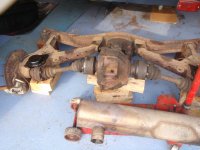I have researched the forum for the best way to bleed the brake system, there is a little conflicting information and no definitive answer, perhaps it is an art and not a science. Also I have a Right Hand Drive so remote master to the servos.
Here is what I did after a rear axle rebuild and change to stainless flex hoses, hence the system was near empty of fluid.
Dot 4 fluid and a pressure bleeder attached to my bike tyre, so don't know the actual pressure.
1 rear left and right calipers. Bleed nipple is at the top of the caliper.
2 Front left, lower inside nipple, then outer lower nipple, then upper. The manual does not say if lower before upper, but says outer before inner bleed nipples.
3 Front right, as for left.
This gave no pedal resistance.
4 Bled both servos, which gave some air.
Now I have a reasonable pedal resistance, but not perfect.
Repeat all of above again.
Very little air came out this time and what did was in tiny bubbles, like quality champagne!
Pedal movement and resistance pretty good but not perfect, I can’t tell the difference between rubber flex hoses and these steel ones, so suspect a little air still in the system.
Is there a better way to the job than this?
However, she is now back on the road after the rear end rebuild, so here is a before and afterwards shot for your amusement.
Best wishes
C
Here is what I did after a rear axle rebuild and change to stainless flex hoses, hence the system was near empty of fluid.
Dot 4 fluid and a pressure bleeder attached to my bike tyre, so don't know the actual pressure.
1 rear left and right calipers. Bleed nipple is at the top of the caliper.
2 Front left, lower inside nipple, then outer lower nipple, then upper. The manual does not say if lower before upper, but says outer before inner bleed nipples.
3 Front right, as for left.
This gave no pedal resistance.
4 Bled both servos, which gave some air.
Now I have a reasonable pedal resistance, but not perfect.
Repeat all of above again.
Very little air came out this time and what did was in tiny bubbles, like quality champagne!
Pedal movement and resistance pretty good but not perfect, I can’t tell the difference between rubber flex hoses and these steel ones, so suspect a little air still in the system.
Is there a better way to the job than this?
However, she is now back on the road after the rear end rebuild, so here is a before and afterwards shot for your amusement.
Best wishes
C


